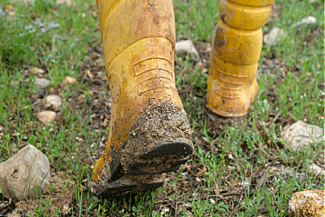Your best bet is to find an arborist who can inspect your property for toxic or invasive plants, says Brandt.
8 Signs You’re Buying Land That’s a Silent, Massive Money Pit
When homebuyers tour potential homes, most can spot obvious problems like a bad grout job in the bathroom or an outdated kitchen. But do you know what to look for outside the house, on the land beneath your feet?
Land is more of a mystery to homebuyers, since variables such as soil quality and proper drainage aren’t easy to eyeball. Still, it’s important to get the dirt on it, since it can hide a variety of issues that can cause major problems for the homeowner and be costly to fix (if it can be fixed at all).
To help you ferret out these expensive issues, here are some red flags that can commonly be found lurking on a bad piece of property. While these signs don’t mean you have to bail on real estate you adore, they might mean it’s smart to conduct a soil test or call in an expert who can tell you more.
1. Mushy grass

Along with poor drainage, a lot of wetness could mean you have clay soil, which can be hard to plant in.
“This problem could also mean you’ve got overflow from adjacent areas or there might be a break in the irrigation system,” adds Cassy Aoyagi, a landscaping professional and president of FormLA Landscaping.
A good rule of thumb when buying any type of land is to check with the local assessor’s office to see if the spot is in a flood zone.
Aoyagi advises folks to “steer clear of areas even in 100-year flood plains or ones flanked by asphalt, cement, or other hardscape, since these just make flooding worse.”
2. Trees on the south side
Want the bulbs and lettuce you plant to thrive? Think twice about a yard with tall trees planted on the south side.
“You want to see tall trees on the north side instead as south-facing trees block the sun,” says Lambton. Trees on the northern part allow more rays, making it easier to grow a lawn and other plantings.
3. Nothing’s growing—at all
If there’s nary a blade of grass, beware.
“Get the soil checked out for previous contamination because if the spot was once a gas station, for example, it won’t be a great place for planting vegetables,” says Susan Brandt, the genius green thumb at Blooming Secrets.
“The previous owner may have cleared the site with a toxic chemical herbicide, which is an even bigger concern for kids and pets,” says Aoyagi.
4. The property is on a hill
Why struggle mowing a sloped property?
“I always tell people to avoid an incline or gully because it means it’s tough to grow things and you can’t use the yard to its fullest potential,” says Lambton.
Still, if the land you love is on a steep hill, there are ways to work with the property.
Aoyagi and her crack team have planted native flora that root deeply on slopes, and they’ve also installed nifty retaining walls to improve the ground’s use and looks.
5. Climbing vines and ivy
Thick green coverage on a home’s walls can seem like a fairy tale, but some of these can wreck a house.
“Wisteria and ivy are very pretty, but they can damage wood shingles as well as harm stucco and brick and even dig under the eaves,” says Brandt.
6. Yellow-brown grass
Patchy spots on the lawn aren’t ideal, alas, as they could indicate fertilizer has burned the ground or grubs and other pests are present.
Brandt recommends a soil test to learn the quality of dirt you’re dealing with.
“You might just need to amend the soil by top dressing it with a compost mix to add nutrients and then till, seed, and water it to bring back a green lawn,” says Lambton.
7. Synthetic turf or gravel
A hardscape yard is sometimes a conscious choice (think pretty pavers and stone paths), but lots of gravel that’s present without an actual design could mean the soil is nutrient-deprived and won’t sustain a real lawn.
“A hardscape on the property could also be a sign of some damage on it in the past,” says Aoyagi.
8. Toxic plants
If you have a curious dog, you’ll want to avoid certain plants and flowers in the yard. Oleanders, seen here, are highly toxic to humans and animals if eaten, as are dahlias, daffodils, and English ivy.















 Accessibility
Accessibility